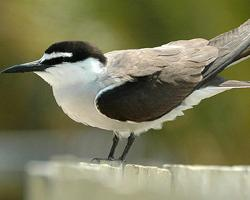
State of endangerment
| Endangered |
Animal description
The Bridled Tern, scientifically named Onychoprion anaethetus, is a captivating species of seabird that belongs to the family Laridae, which includes gulls, terns, and skimmers. This medium-sized tern is distinguished by its sleek and graceful appearance, with a length typically ranging from 30 to 32 centimeters and a wingspan that stretches approximately 77 to 81 centimeters.One of the most striking features of the Bridled Tern is its plumage. The upper parts of the bird are predominantly a sooty grey, which contrasts beautifully with its white underparts. The forehead is also white, extending back to an eye-catching black cap that covers the crown and nape. A distinctive feature of this species is the thin white line, or "bridle," that runs from the base of the bill, around the eye, to the back of the head, giving the bird its common name. The bill itself is relatively short and slender, colored black, which complements the bird's dark legs and webbed feet.
The Bridled Tern's tail is deeply forked, a characteristic feature of many tern species, which aids in its agility and maneuverability in flight. This bird is an excellent flyer, capable of performing intricate aerial maneuvers as it hunts for fish. It feeds primarily by plunge-diving into the ocean, capturing small fish and marine invertebrates just below the surface.
Breeding behavior of the Bridled Tern is as fascinating as its physical appearance. They are colonial nesters, often breeding on isolated, predator-free islands. Unlike many other seabirds, Bridled Terns do not construct a traditional nest; instead, they lay their eggs on the ground, in shallow depressions on bare rock or sand, sometimes lined with vegetation or coral fragments. Both parents share the responsibilities of incubating the single egg and feeding the chick once it hatches.
The Bridled Tern is a migratory species, with populations moving seasonally between breeding and wintering grounds. They breed in scattered locations across the tropical and subtropical regions of the Atlantic, Pacific, and Indian Oceans. Outside the breeding season, these terns disperse widely across the open ocean, often far from land, showcasing their remarkable adaptability to the marine environment.
Despite facing threats such as habitat loss, human disturbance at nesting sites, and the impacts of climate change, the Bridled Tern is currently classified as Least Concern by the International Union for Conservation of Nature (IUCN). This status reflects the bird's wide distribution and presumably large global population. However, continued monitoring and conservation efforts are essential to ensure that this elegant seabird remains a common sight over the world's oceans.
In summary, the Bridled Tern is a striking and agile seabird with distinctive plumage and fascinating life habits. Its ability to adapt to a life almost entirely at sea, combined with its graceful flight and communal breeding practices, makes it a remarkable example of avian adaptation and resilience.
Similar Animals
New photos of animals
Top 10 animals
- Dolphin gull (Leucophaeus scoresbii)
- Diana monkey (Cercopithecus diana)
- Moustached guenon (Cercopithecus cephus)
- Galápagos tortoise (Geochelone nigra complex)
- Japanese macaque (Macaca fuscata)
- Stone loach (Barbatula barbatula)
- Greek tortoise (Testudo graeca)
- Russian tortoise (Testudo horsfieldii)
- Common flying dragon (Draco volans)
- Galápagos penguin (Spheniscus mendiculus)


